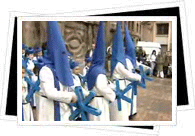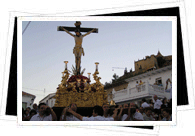
While the dates of Spain's world-famous Semana Santa (Holy Week) change each year according to Christian calendar, count on early spring to experience the music, the art, the processions and the drama.

While cities, towns and villages throughout Spain gear up for their own unique Semana Santa celebrations, the Andalucían city of Sevilla is the top spot for an experience that will leave you wide-eyed with awe.
The art, the music and the drama of Spain's Semana Santa celebrations have launched the festival into the international limelight- particularly in Sevilla, where the festivities are more jubilant than the more solemn version typical of most other Spanish destinations. The stars of Semana Santa are the festival's impressive processions and lavishly adorned floats. Now these aren't just any old parade floats; Semana Santa's infamous floats are topped with important 16th and 17th century sculptures of Christ and the Virgin Mary sitting amidst hundreds of fresh flowers and candles.

Each float is hauled around town upon the shoulders of up to 40 men hidden- no easy feat, considering some these processions can last up to 14 hours! These young men, called costaleros, practice with mock floats for months prior to Semana Santa in Spain- and it shows. Marching perfectly in sync with each other and to the soulful music of coronets and drums, the figures above sway back and forth, looking eerily as though they are walking alon gto the music.
Accompanying each procession's floats - typically one of the Virgin and one depicting a scene from Christ's Passion - is an entourage of musicians and endless rows of penitents, or nazarenos. Covered from head to toe and marching for hours on end, many of Spain's Semana Santa penitents even complete the entire procession barefoot. Don't be thrown off by the resemblance between the pointed hoods and long robes of the nazarenos and thsoe of the Ku Klux Klan- the one has nothing to do with the other!
Semana Santa processions in Spain's various cities and towns generally follow long-standing official Semana Santa routes. You can get a Semana Santa map with a comprehensive time schedule of where to go and when- pinpointed right down to the minute!
People often dress nicely to watch the processions, particularly during the more solemn second half of Semana Santa. You're bound to see women dressed to the nines and many men braving the beating sun in full suits. However, not everyone dresses up quite as much; the rule of thumb is that if you want to fit in during Semana Santa, leave your ripped jeans and paint-stained shirt for another day!